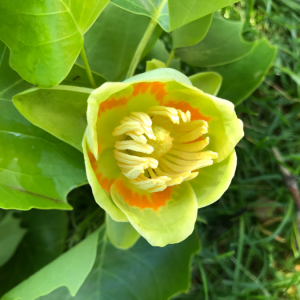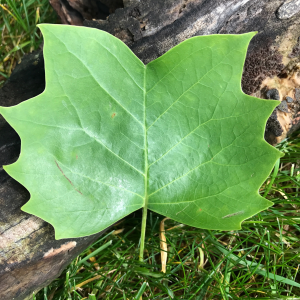What’s in a Plant Name: Liriodendron tulipifera L.
Posted in Horticulture on June 21 2017, by Katherine Wagner-Reiss
Katherine Wagner-Reiss has her certificate in botany from NYBG and has been a tour guide here for two years.

The NYBG Tulip Tree Allée is a NYC Landmark. Twenty-six Liriodendron tulipifera L. were planted in 1903. While it is unusual for a Landmark to be composed of living things, people should be able to enjoy this Landmark for hundreds of years to come, since the trees were 10 years old at planting and individual tulip trees have been known to live for 500 years. These majestic trees are in the magnolia family.
As you face the Library Building, notice one tulip tree with a larger girth in the uppermost left-hand corner; as the Library was being built, this original tree was preserved and it may well have been the inspiration for planting the other 26.
Now, to dissect the Latinized name: Lirio derives from the Greek word for lily, dendron from the Greek word for tree, and tulipifera means “tulip-bearing.” Curious that both the leaves and the flowers have a tulip shape! Whenever I see the L. after the species name, I feel a close tie with history, since that signifies that Carl Linnaeus, the father of botany, officially gave that Latinized name to the plant.
Two species of Liriodendron are known: the native L. tulipifera L. and L. chinense Sarg., native to China. If you look for L. chinense in the Liasson Daffodil Valley behind the Library Building, you will easily recognize it as a tulip tree. However, this species has more deeply lobed leaves and the flowers show only green and yellow, lacking the orange band of the native species.

NYBG also grows two cultivars of Liriodendron tulipifera L. ‘Ardis’ is a dwarf in the Ross Conifer Collection near the spruces. The origins of cultivar names are often mysterious, but through the research of Esther Jackson at the NYBG Library I learned that ‘Ardis’ was the first name of Mrs. W.F. Sonnemann, the woman who, with her husband, selected this cultivar. A second cultivar, ‘Fastigiata’ (meaning columnar), has been growing in the Magnolia/Oak collection since 1895! Other cultivars are available commercially—some with variegated leaves.
The tulip tree has great significance in the history of NYBG, and in celebration of its 100th anniversary, 500 two-year-old tulip trees were given to the NYC Department of Parks and Recreation.
So enjoy the Tulip Tree Allée, beautiful in all four seasons, and made all the more striking at this time by the Chihuly resin sculpture in the Fountain of Life at the head of the Allée.


Great blog, Katherine! Thanks for the shout-out to the library. :)